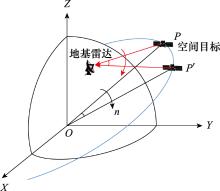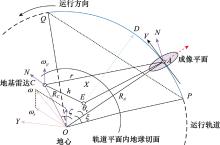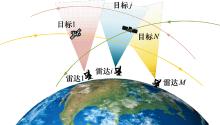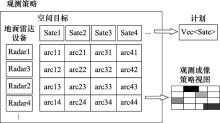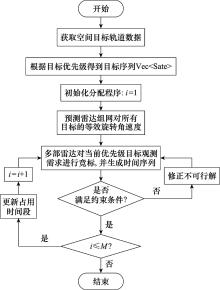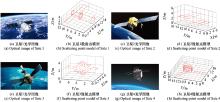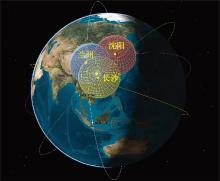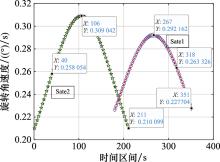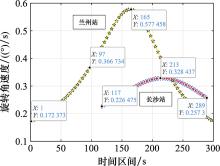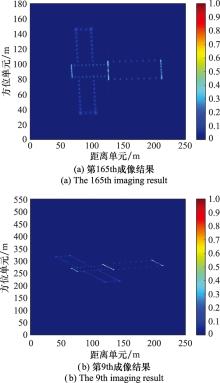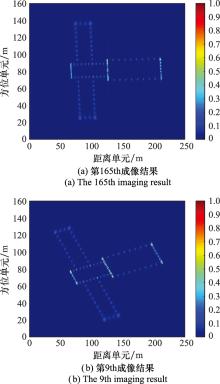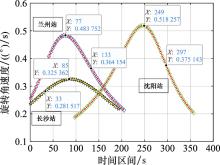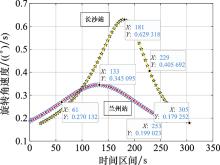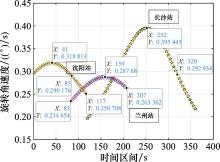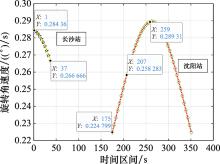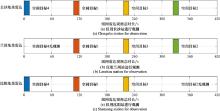Systems Engineering and Electronics ›› 2025, Vol. 47 ›› Issue (1): 81-93.doi: 10.12305/j.issn.1001-506X.2025.01.09
• Sensors and Signal Processing • Previous Articles Next Articles
Multi-orbit targets ISAR imaging resource allocation algorithm for netted radar based on auction theory
Libing JIANG, Qingwei YANG, Shuyu ZHENG, Zhuang WANG
- College of Electronic Science and Technology, National University of Defense Technology, Changsha 410073, China
-
Received:2023-03-08Online:2025-01-21Published:2025-01-25 -
Contact:Zhuang WANG
CLC Number:
Cite this article
Libing JIANG, Qingwei YANG, Shuyu ZHENG, Zhuang WANG. Multi-orbit targets ISAR imaging resource allocation algorithm for netted radar based on auction theory[J]. Systems Engineering and Electronics, 2025, 47(1): 81-93.
share this article
Table 2
TLE information of four space-based target"
| 目标编号 | TLE数据 |
| Sate 1 | 1, 38109U, 12014A, 22 108.108 935 92, .000 000 00, 00000-0, 00000-0 0, 9 999 2, 38 109, 40.265 4, 20.456 400 561 25, 00.175 0, 25.012 2, 14.823 846 490 422 55 |
| Sate 2 | 1, 35937U, 09052A, 22 098.865 138 83, .000 000 00, 00000-0, 00000-0 0, 9 996 2, 35 937, 28.563 2, 340.596 400 435 87, 00.057 5, 00.142 5, 15.482 625 175 483 62 |
| Sate 3 | 1, 41848U, 16067A, 22 111.873 446 13, .000 323 17, 00000-0, 18633-3 0, 9 993 2, 41 848, 98.574 1, 280.565 600 151 45, 20.291 5, 150.874 7, 13.699 350 983 908 71 |
| Sate 4 | 1, 42767U, 17036C, 22 100.892 220 90, .000 007 46, 00000-0, 38662-4 0, 9 991 2, 42 767, 52.568 7, 80.698, 400 193 54, 30.904 8, 108.574 0, 12.849 075 506 670 43 |
Table 10
Comparison of imaging result indicators"
| 算法 | 指标 | Sate 1 | Sate 2 | Sate 3 | Sate 4 |
| 本文算法 | 旋转角速度/((°)/s) | 0.518 | 0.629 | 0.395 | 0.289 |
| 成像所需时长/s | 7.72 | 6.36 | 10.13 | 13.84 | |
| 图像熵 | 1.345 | 0.954 | 1.336 | 2.895 | |
| 对比度 | 1.197 | 0.924 | 0.226 | 1.032 | |
| 平均算法 | 旋转角速度/((°)/s) | 0.325 | 0.265 | 0.393 | 0.284 |
| 成像所需时长/s | 12.31 | 15.09 | 10.18 | 14.08 | |
| 图像熵 | 2.046 | 3.011 | 1.374 | 2.895 | |
| 对比度 | 0.828 | 0.310 | 0.210 | 1.032 |
| 1 | DELANDE E , FRUEH C , FRANCD J , et al. Novel multi-object filtering approach for space situational awareness[J]. Journal of Guidance, Control, and Dynamics, 2017, 41 (1): 59- 73. |
| 2 |
DU Y H , JIANG Y C , WANG Y , et al. ISAR imaging for low earth-orbit target based on coherent integrated smoothed generalized cubic phase function[J]. IEEE Trans.on Geoscience and Remote Sensing, 2020, 58 (2): 1205- 1220.
doi: 10.1109/TGRS.2019.2944629 |
| 3 |
ZHENG S Y , JIANG L B , YANG Q W , et al. Adaptive PHD filter with RCS and Doppler feature for space targets tracking via space-based radar[J]. IEEE Trans.on Aerospace and Electronic Systems, 2024, 60 (4): 3750- 3765.
doi: 10.1109/TAES.2023.3327692 |
| 4 |
WANG H B , CHEN Y J , ZHANG Y P , et al. High-resolution ISAR imaging method for maneuvering targets based on hybrid transformer[J]. IEEE Trans.on Antennas and Propagation, 2023, 71 (10): 8250- 8265.
doi: 10.1109/TAP.2023.3306386 |
| 5 |
JIANG L B , ZHENG S Y , YANG Q W , et al. A modified OMP method for multi-orbit three dimensional ISAR imaging of the space target[J]. Journal of Systems Engineering and Electronics, 2023, 34 (4): 879- 895.
doi: 10.23919/JSEE.2023.000066 |
| 6 | JIANG Y C , WEI J , LIU Z T , et al. A novel three-dimension imaging algorithm based on trajectory association of ISAR image sequence[J]. IEEE Geoscience and Remote Sensing Letters, 2023, 20, 4000405. |
| 7 | 丁建江, 许红波, 周芬. 雷达组网技术[M]. 北京: 国防工业出版社, 2017: 13- 33. |
| DING J J , XU H B , ZHOU F . The technology of netted radar system[M]. Beijing: National Defense Industry Press, 2017: 13- 33. | |
| 8 |
YAN J K , LIU H W , BAO Z . Power allocation scheme for target tracking in clutter with multiple radar system[J]. Signal Processing, 2018, 144, 453- 458.
doi: 10.1016/j.sigpro.2017.11.006 |
| 9 |
GARCIA N , HAIMOVICH A M , COULON M , et al. Resource allocation in MIMO radar with multiple targets for non-coherent localization[J]. IEEE Trans.on Signal Processing, 2014, 62 (10): 2656- 2666.
doi: 10.1109/TSP.2014.2315169 |
| 10 | GARCIA N, COULON M, LOPS M, et al. Resource allocation in radar networks for non-coherent localization[C]//Proc. of the IET International Conference on Radar Systems, 2012: 14-19. |
| 11 |
李正杰, 谢军伟, 张浩为, 等. 基于集中式MIMO雷达的功率带宽联合分配算法[J]. 系统工程与电子技术, 2020, 42 (5): 1041- 1049.
doi: 10.3969/j.issn.1001-506X.2020.05.10 |
|
LI Z J , XIE J W , ZHANG H W , et al. Joint power and bandwidth allocation algorithm based on collocated MIMO radar[J]. Systems Engineering and Electronics, 2020, 42 (5): 1041- 1049.
doi: 10.3969/j.issn.1001-506X.2020.05.10 |
|
| 12 |
李正杰, 谢军伟, 张浩为, 等. 角闪烁噪声下的集中式MIMO雷达自适应资源分配算法[J]. 系统工程与电子技术, 2022, 44 (2): 498- 505.
doi: 10.12305/j.issn.1001-506X.2022.02.18 |
|
LI Z J , XIE J W , ZHANG H W , et al. Adaptive resource allocation algorithm in collocated MIMO radar under angular glint noise[J]. Systems Engineering and Electronics, 2022, 44 (2): 498- 505.
doi: 10.12305/j.issn.1001-506X.2022.02.18 |
|
| 13 |
YI W , YUAN Y , HOSEINNEZHAD R , et al. Resource sche-duling for distributed multi-target tracking in netted collocated MIMO radar systems[J]. IEEE Trans.on Signal Processing, 2020, 68, 1602- 1617.
doi: 10.1109/TSP.2020.2976587 |
| 14 |
龚树凤, 龙伟军, 贲德, 等. 组网雷达自适应模糊CFAR检测融合算法[J]. 系统工程与电子技术, 2022, 44 (1): 100- 107.
doi: 10.12305/j.issn.1001-506X.2022.01.14 |
|
GONG S F , LONG W J , BEN D , et al. Adaptive fuzzy CFAR detection fusion algorithm for netted radar[J]. Systems Engineering and Electronics, 2022, 44 (1): 100- 107.
doi: 10.12305/j.issn.1001-506X.2022.01.14 |
|
| 15 | 卢建斌. 相控阵雷达资源优化管理的理论与方法[D]. 长沙: 国防科学技术大学, 2007. |
| LU J B. Theory and method of resource optimization and management for phased array radars[D]. Changsha: National University of Defense Technology, 2007. | |
| 16 |
SUN H , LI M , ZUO L , et al. Joint radar scheduling and bea-mpattern design for multitarget tracking in netted collocated MIMO radar systems[J]. IEEE Signal Processing Letters, 2021, 28, 1863- 1867.
doi: 10.1109/LSP.2021.3108675 |
| 17 | 余若峰, 杨威, 付耀文, 等. 面向不同雷达任务的认知波形优化综述[J]. 电子学报, 2022, 50 (3): 726- 752. |
| YU R F , YANG W , FU Y W , et al. A review on cognitive waveform optimization for different radar missions[J]. Acta Electronica Sinica, 2022, 50 (3): 726- 752. | |
| 18 | 陈怡君, 罗迎, 张群, 等. 基于认知ISAR成像的相控阵雷达资源自适应调度算法[J]. 电子与信息学报, 2014, 36 (7): 1566- 1572. |
| CHEN Y J , LUO Y , ZHANG Q , et al. Adaptive scheduling algorithm for phased array radar based on cognitive ISAR imaging[J]. Journal of Electronics & Information Technology, 2014, 36 (7): 1566- 1572. | |
| 19 |
CHEN Y J , ZHANG Q , LUO Y , et al. Multi-target radar imaging based on phased-MIMO technique—Part Ⅰ: imaging algorithm[J]. IEEE Sensors Journal, 2017, 17 (19): 6185- 6197.
doi: 10.1109/JSEN.2017.2731806 |
| 20 |
CHEN Y J , ZHANG Q , LUO Y , et al. Multi-target radar imaging based on phased-MIMO technique—Part Ⅱ: adaptive resource allocation[J]. IEEE Sensors Journal, 2017, 17 (19): 6198- 6209.
doi: 10.1109/JSEN.2017.2740038 |
| 21 |
LIU X W , ZHANG Q , LUO Y , et al. ISAR imaging task allocation for multi-target in radar network based on potential game[J]. IEEE Sensors Journal, 2019, 19 (23): 11192- 11204.
doi: 10.1109/JSEN.2019.2936423 |
| 22 |
CHEN Y J , ZHANG Q , YUAN N , et al. An adaptive ISAR-imaging-considered task scheduling algorithm for multi-function phased array radar[J]. IEEE Trans.on Signal Processing, 2015, 63 (19): 5096- 5110.
doi: 10.1109/TSP.2015.2449251 |
| 23 | 孟迪, 张群, 罗迎, 等. 基于脉冲交错的ISAR成像雷达资源自适应调度算法[J]. 空军工程大学学报(自然科学版), 2017, 18 (2): 25- 31. |
| MENG D , ZHANG Q , LUO Y , et al. An adaptive scheduling algorithm for ISAR imaging radar based on pulse interleaving[J]. Journal of the Air Force Engineering University (Natural Science Edition), 2017, 18 (2): 25- 31. | |
| 24 | 田泰方, 张群, 陈怡君, 等. 基于二维资源管理的多功能雷达任务调度算法[J]. 航空学报, 2018, 39 (12): 295- 305. |
| TIAN T F , ZHANG Q , CHEN Y J , et al. A task scheduling algorithm for multifunctional radar based on two-dimensional resource management[J]. Acta Aeronautica et Astronautica Sinica, 2018, 39 (12): 295- 305. | |
| 25 | XU F Y, WANG R F, MAO D Q, et al. Resource allocation optimization of distributed radar imaging system based on spatial spectrum analysis[C]//Proc. of the IEEE International Geo-science and Remote Sensing Symposium, 2019: 9101-9104. |
| 26 | 冯德军, 王雪松, 肖顺平, 等. 空间目标雷达成像仿真研究[J]. 航天电子对抗, 2005, 21 (2): 21- 24. |
| FENG D J , WANG X S , XIAO S P , et al. Research on radar imaging simulation of space target[J]. Aerospace Electronic Warfare, 2005, 21 (2): 21- 24. | |
| 27 | 周叶剑, 张磊, 王虹现, 等. 空间轨道目标的逆合成孔径雷达成像质量分析[J]. 雷达学报, 2017, 6 (1): 17- 24. |
| ZHOU Y J , ZHANG L , WANG H X , et al. Performance analysis on ISAR imaging of space targets[J]. Journal of Radars, 2017, 6 (1): 17- 24. | |
| 28 | 赵莉芝. 空间目标干涉三维ISAR成像技术研究[D]. 北京: 北京理工大学, 2015. |
| ZHAO L Z. Research of interferometric 3D ISAR imaging for space target[D]. Beijing: Beijing Institute of Technology, 2015. | |
| 29 | 陈津. 空间目标ISAR成像方法与特征分析研究[D]. 北京: 北京理工大学, 2016. |
| CHEN J. Research on ISAR imaging method and feature analysis of space target[D]. Beijing: Beijing Institute of Technology, 2016. | |
| 30 | BAI X S , ANDRES F , MAXIMILIAN K . Group-based distributed auction algorithms for multi-robot task assignment[J]. IEEE Trans.on Automation Science and Engineering, 2023, 20 (2): 1292- 1303. |
| 31 | MANOBENDU S , ABRAHAM O F . Access point-user association and auction algorithm-based pilot assignment schemes for cell-free massive MIMO systems[J]. IEEE Systems Journal, 2023, 17 (3): 4301- 4312. |
| [1] | Kai XIAO, Guoyao XIAO, Zongzheng SUN, Duopeng WANG, Yinghui QUAN. Design and verification of miniaturized broadband reconnaissance and jamming integrated system [J]. Systems Engineering and Electronics, 2025, 47(1): 22-33. |
| [2] | Zhikang JI, Zinan ZHOU, Xuanpeng LI. Self-constrained search density based clustering algorithm for radar signal sorting [J]. Systems Engineering and Electronics, 2025, 47(1): 62-69. |
| [3] | Yang MENG, Guoru ZHOU, Jie LI, Bingchen ZHANG. Discriminative sparse microwave imaging method based on structured dictionary learning [J]. Systems Engineering and Electronics, 2025, 47(1): 94-100. |
| [4] | Xiankang SU, Dawei ZHANG, Fang YE. Radar signal sorting method based on hierarchical clustering and spectral adaptation [J]. Systems Engineering and Electronics, 2025, 47(1): 101-108. |
| [5] | Tong OUYANG, Ling WANG, Daiyin ZHU, Yong LI. Fine-grained recognition method for meteorological targets in ResNeXt fused with LightGBM [J]. Systems Engineering and Electronics, 2024, 46(12): 4034-4043. |
| [6] | Dongsheng ZHU, Xiaojing SU, Zhixun MA, Yingjie SHI. Design of adaptive detector for inhomogeneous clutter background [J]. Systems Engineering and Electronics, 2024, 46(11): 3613-3620. |
| [7] | Lei WANG, Qian SU, Gao WEI, Jianzhou LI. Micro-Doppler feature extraction method for space coningtarget based on synchro-extracting transform and ridge detection [J]. Systems Engineering and Electronics, 2024, 46(11): 3684-3689. |
| [8] | Jian GUAN, Xingyu JIANG, Ningbo LIU, Hao DING, Yong HUANG. Dual-polarized maximum eigenvalue-based target detection in sea clutter environment [J]. Systems Engineering and Electronics, 2024, 46(11): 3715-3725. |
| [9] | Huifu WANG, Mingfei MEI, Liang QI, Heng CHAI, Shifei TAO. Radiation source signal recognition method based on binary neural networks [J]. Systems Engineering and Electronics, 2024, 46(11): 3912-3919. |
| [10] | Zhian DENG, Zhiguo WANG, Sheng'ao WANG, Weijian SI. Radar signal modulation recognition method based on synchro-extracting transform denoising [J]. Systems Engineering and Electronics, 2024, 46(10): 3334-3346. |
| [11] | Fatong ZHANG, Yaowen FU, Wei YANG, Wenpeng ZHANG, Shangqu YAN. Wide-beam motion compensation algorithm for micro-UAV FMCW SAR [J]. Systems Engineering and Electronics, 2024, 46(10): 3303-3311. |
| [12] | Jingyuan SHAN, Yu LU, Hanyu LING. Robust adaptive multi-target tracking algorithm for airborne passive bistatic radar [J]. Systems Engineering and Electronics, 2024, 46(9): 2902-2915. |
| [13] | Jianguo YIN, Wen SHENG, Wei JIANG. Radar air target recognition based on deep residual shrinkage network [J]. Systems Engineering and Electronics, 2024, 46(9): 3012-3018. |
| [14] | Xin YANG, Kaizhi RUAN, Hongming LIU, Xiaoke WANG, Jingqiu LIU, Yusheng SHI. Anti-bias track association algorithm based on target measurement error distribution [J]. Systems Engineering and Electronics, 2024, 46(8): 2820-2828. |
| [15] | Caiyun WANG, Huiwen ZHANG, Jianing WANG, Yida WU, Yun CHANG. Ballistic midcourse target RCS recognition based on DTCWT-VAE [J]. Systems Engineering and Electronics, 2024, 46(7): 2269-2275. |
| Viewed | ||||||
|
Full text |
|
|||||
|
Abstract |
|
|||||
